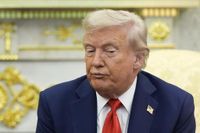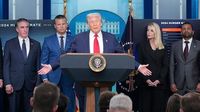President Donald Trump has once again upended political expectations, this time by floating the idea of a Republican National Convention to be held before the 2026 midterm elections. The proposal, which Trump unveiled on August 28, 2025, via his favored social media platform, Truth Social, marks a dramatic departure from decades of political tradition in the United States. National conventions have long been the domain of presidential election years, staged every four years to rally the party faithful and formally nominate candidates. But Trump, never one to shy away from spectacle or to let precedent stand in his way, is now considering bringing the pageantry of the convention to the midterm cycle.
“The Republican Party is doing really well. Millions of people have joined us,” Trump wrote in his post, as reported by Newslooks. “We have raised far more money than the Democrats … In that light, I am thinking of recommending a National Convention … just prior to the Midterms. It has never been done before. STAY TUNED!” The statement, which quickly reverberated through political circles, signals Trump’s intent to showcase the GOP’s confidence and momentum ahead of what is expected to be a fiercely contested election season.
According to The Washington Post, Trump’s suggestion comes as both major parties gear up for a midterm cycle that is shaping up to be anything but ordinary. Not to be outdone, Democrats are reportedly considering their own pre-midterm convention, with Democratic National Committee Chair Ken Martin supporting the idea, according to a party official who spoke on condition of anonymity. The move, still under discussion, demonstrates just how much the 2026 midterms have become a battleground not just for votes, but for the narrative that will shape the run-up to November.
For Republicans, the stakes couldn’t be higher. The party is defending slim majorities in both the House and Senate, and the electoral landscape is rapidly shifting beneath their feet. Redistricting battles have erupted across the country. Earlier this month, Texas passed a new map that cut five Democratic seats, while California Governor Gavin Newsom is seeking a map that would eliminate five Republican seats. In New York, Governor Kathy Hochul and fellow Democrats have vowed to escalate their own redistricting fight. All of this means that every seat, and every vote, could count more than ever before.
Trump’s rationale for a pre-midterm convention is rooted in a desire to rally the party’s base, unify messaging, and capitalize on what he describes as unprecedented fundraising momentum. “The Republican Party is doing really well and is poised to WIN BIG IN THE MIDTERMS,” Trump declared, echoing his signature bravado. He pointed to the party’s financial edge: “We have raised far more money than the Democrats,” he wrote, as noted by Newslooks. This fundraising advantage, Trump argues, is a key indicator of grassroots enthusiasm and organizational strength.
But Trump’s ambitions go beyond the party’s coffers. He has placed crime squarely at the center of the GOP’s midterm strategy, portraying Republicans as the party of law and order. “The Republicans are the party that wants to stop crime. We’re against crime. The Democrats like crime,” Trump said this week, as reported by Newslooks. He linked this message to his controversial federalization of Washington, D.C.’s police force and the deployment of National Guard troops earlier in August. “In 12 days we’ve made it so safe. This is going to be the safest place on Earth,” Trump claimed, underscoring his determination to make public safety a defining issue for the campaign.
Of course, the convention idea has its supporters and critics within the Republican ranks. House Speaker Mike Johnson (R-Louisiana) wasted no time in backing the proposal, posting on X, “YES, Mr. President! Let’s go!!!!” The final decision, however, rests with the Republican National Committee, newly chaired by Joe Gruters, a staunch Trump ally. Gruters’ leadership is seen as a sign that the party is likely to align closely with Trump’s vision heading into 2026.
Yet, the move is not without risk. Midterm elections have historically been a tough slog for the party controlling the White House. On average, presidents’ parties lose about 25 House seats in their first midterms, and Trump himself presided over the loss of 41 Republican seats in 2018. With his approval rating sitting at just 37 percent according to a Quinnipiac University poll released on August 27, 2025, Trump faces an uphill battle to defy historical trends. Political observers are quick to note that, while the party has momentum, the president’s own popularity is under pressure.
Democrats, meanwhile, are watching Trump’s maneuvers closely, preparing their own counter-strategies. They argue that Trump’s approach to crime and immigration overreaches executive authority and could alienate independent voters. According to Newslooks, Democrats see the president’s tactics as a double-edged sword: effective at energizing the GOP base, but potentially risky in swing districts where moderate voters might balk at his hardline stances.
Redistricting remains a central flashpoint. Texas, California, and New York are all in the midst of heated battles over district maps, with each side accusing the other of gerrymandering to tilt the playing field. These fights are more than just inside baseball—they could determine which party controls Congress after 2026. For Republicans, the ability to shore up their razor-thin House majority may depend as much on the outcome of these legal and legislative skirmishes as on the campaign trail itself.
Trump’s willingness to break the mold and stage a convention in a non-presidential year reflects his broader approach to politics: disrupt the status quo, seize the spotlight, and keep both supporters and opponents guessing. The move also underscores the importance of spectacle in modern American politics. A pre-midterm convention would offer the GOP a chance to highlight its rising stars, energize activists, and dominate the news cycle at a critical juncture.
But will it work? That remains the million-dollar question. Trump’s strategy hinges on his ability to mobilize the base, out-fundraise Democrats, and frame the midterms around issues—like crime—that resonate with his core supporters. Democrats, for their part, hope to leverage Trump’s polarizing presence to rally their own voters and win over the ever-crucial independents.
As the 2026 midterms draw closer, one thing is clear: American politics is entering uncharted territory. Whether or not the Republican National Committee gives Trump the green light for a pre-midterm convention, the mere suggestion has already changed the conversation. Both parties are now rethinking their strategies, their messaging, and their playbooks for what promises to be a high-stakes, high-drama election season.
In this turbulent political moment, Trump’s gambit is a reminder that, for better or worse, the rules of the game are always subject to change. The coming months will reveal whether his latest move is a stroke of genius—or a gamble that backfires.



